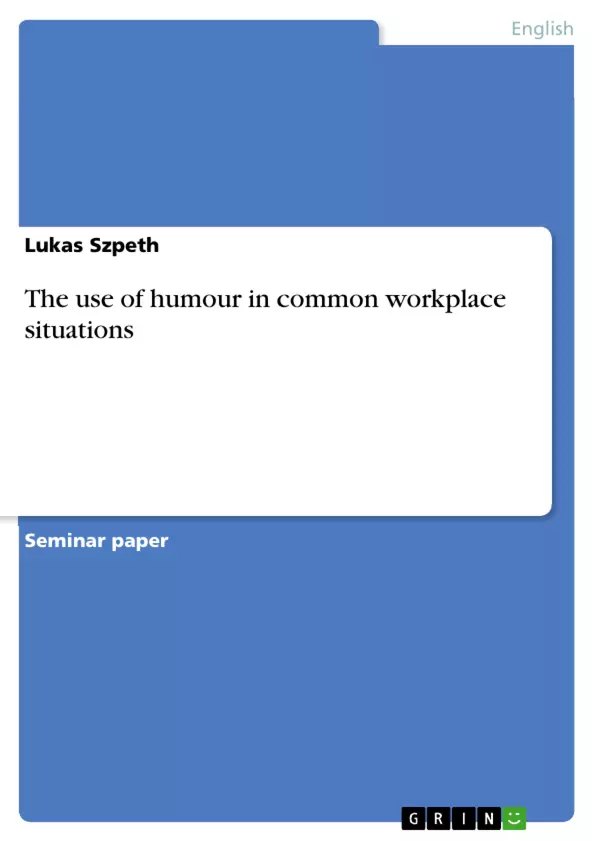This term paper will talk about the different characters or functions of humour with special consideration of workplace situations. This will be including the use of humour to create solidarity contrary to rivalrous humour and repressive vs subversive humour.
It will become clear that humour is multifunctional and can work on different levels, which makes defining it difficult. Furthermore it tries to enlighten the linguistic strategies involved. Here the role of power will be looked at. The work shows what humour reveals about power relationships and its use either to enforce or to lessen status differences.
The connection between the individual and a group can be defined through humour. How solidarity is achieved will be investigated. Afterwards, it is about the relation between humour and gender being followed by the strategy to create workplace harmony. The issue of how humour contributes to group life, the way it affects social relations will be another point of interest.
Last but not least, it tries to show what kind of reactions can be evoked by using humour. It can work as tension releaser, as well as an aggression diffuser. Further possibilities of use are to hedge directives and to hide criticism which can trouble the participants. Especially the trouble of responding correctly to these will be an issue of discussion. The ambivalence of humour can be seen here again, which, once more, makes the problem of defining humour clear.
Inhaltsverzeichnis (Table of Contents)
- Introduction
- Defining Humour
- Humour and the Workplace
- The Functions of Humour
- Creating Solidarity
- Joint Humour
- Jocular Abuse
- Rivalrous Humour
- Repressive Humour
- Subversive Humour
- Creating Solidarity
- Relating Humour
- Humour and Power
- Lessening Power Differences
- Enforcing The Differences
- Solidarity and Group Behaviour
- Humour and Gender
- Creating Workplace Harmony
- Humour and Power
- Using Humour
- The Strategic Use in Workplace Environment
- Releasing Tension
- Diffusing Aggression
- Reactions to Humour
- Unsuccessful Humour
- Humour and the Language Barrier
- Unintentional Humour
- Unsuccessful Humour
- Workplace Humour on Television
Zielsetzung und Themenschwerpunkte (Objectives and Key Themes)
This term paper aims to explore the multifaceted nature of humor in the context of workplace situations, examining its various roles, functions, and implications for social interactions.
- The defining characteristics and ambiguity of humor, including its multiple functions.
- The impact of humor on power dynamics in the workplace, particularly its potential to either lessen or reinforce status differences.
- The role of humor in fostering solidarity and group cohesion, as well as its influence on social relations.
- The interplay between humor and gender, investigating its potential to create or disrupt workplace harmony.
- The various reactions to humor, including unsuccessful or unintentional instances, and the challenges of navigating cultural and language differences.
Zusammenfassung der Kapitel (Chapter Summaries)
- Introduction: This chapter sets the stage for the paper, introducing the topic of humor in the workplace and outlining the key areas of investigation. The introduction emphasizes the multifunctional nature of humor and its potential to reveal power dynamics, create solidarity, and shape social relations.
- Defining Humour: This chapter explores the complexities of defining humor, acknowledging its multi-faceted nature and the challenges of providing a comprehensive definition. The chapter discusses various theoretical perspectives on humor, including those emphasizing cognitive dissonance, intentionality, and the role of the listener.
Schlüsselwörter (Keywords)
This paper focuses on the pragmatics of business communication, specifically the use of humor in common workplace situations. Key themes include the multifunctionality of humor, its role in power dynamics and social interaction, and the challenges of navigating humor across cultural and language barriers.
- Citation du texte
- Lukas Szpeth (Auteur), 2010, The use of humour in common workplace situations, Munich, GRIN Verlag, https://www.grin.com/document/542923



